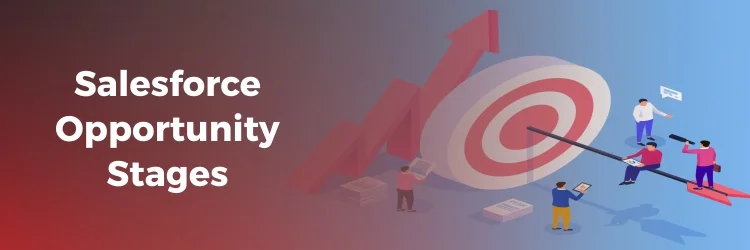Opportunity! We all love Opportunities. It conjures images of wide-open spaces to build, treasures to uncover, and dragons to slay. Implicit in the word is that there is a reward on the other side of the opportunity.
Salesforce offers "Opportunity" as well. In two ways. The first, of course, is the opportunity that Salesforce offers - increased efficiency, increased sales, and more profit. The other is the app that is a part of Salesforce called "Opportunity."
The Opportunity tab opens a new definition of the word. And here, Opportunity comes in stages. They're the different steps Salesforce users take to sell a product or service. This is usually called a company's Sales Process.
Now, Salesforce offers default Opportunity Stages, but the gold is in the customization of Opportunity. When synced to your individual sales process, Opportunity opens a whole new world of organization and efficiency.
The advantage of Salesforce Opportunities is the capability to map out a clear-cut, quickly explained sales process. "Salesforce Opportunities" is a tab in the Salesforce Desktop that can unlock access to a real-time list of the status of all sales opportunities. The advantage of this approach is NOT having to open and make entries in a spreadsheet constantly.
But did you know that you can go a step further and customize Opportunities and open an additional spectrum of functionality?
The default Opportunity Stages:
- Prospecting
- Qualification
- Needs Analysis
- Value Proposition
- ID Decision Makers
- Perception Analysis
- Proposal
- Negotiation
- Closed Won
- Closed Lost
5 Steps To Customize Opportunity Stages
As in any sales process, it's essential to map the different stages and what they're made up of. Salesforce is no different.
1. Map your sales process
Define the specific phases of the sales process and determine which will be included in your Salesforce Opportunity Stages. Pick which of the standard opportunity stages work with your sales process as is and which of them need to be customized to fit your operation. Our goal should be to make the stages relevant and easy to understand so each category can be filled correctly.
2. List the entrance and exit criteria for each stage
These stages of Opportunity are not a single goal, could be steps within the stages that need to be completed before moving to the next stage. If the steps are achieved, the process proceeds to the next stage.
3. Probability
Progression through the stages should increase the percentage of the sales process being successful. While the stock Opportunity Stages assigns chances of success, this may not translate to your own experience. So here is an opportunity to customize this stage.
4. Automated opportunity stages
Now we get to see some of the "gold" in the Opportunity Stages. This is where Salesforce can shine. Whenever the next goal is reached, specific tasks are automatically initiated to begin that stage. The information doesn't have to be constantly updated or entered. This makes the process more accurate and efficient.
5. Revise the opportunity stages
Sales is always an evolving process. Opportunity Stages gives you the option to change the criteria required to move the process to the next stage. Any number of stages can be altered or even discarded if necessary.
Best Practices For Salesforce Opportunity Stages
Learning Salesforce Opportunity Stages isn't terribly complicated. Putting what you've learned to work in a way that suits your organization is an entirely different question. Each customer and sales engagement can follow another course, with stages expanded, collapsed, or even absent. Choosing the stages is a Sales Process choice for your company. But there is a road map for achieving your goal.
- Map your current sales process. This is a way to thoughtfully analyze your current operation and then adapt them to the Salesforce Opportunity.
- Each stage needs a reason for being included and a name that clearly describes it. The entrance and exit of a stage should be clear markers.
- Make fewer rather than more stages so the process doesn't add to the workload.
- Multiple sales processes spanning different types of sales should have their own Records Types and Sales Processes.
Customize Your Salesforce Opportunity Stages!
It seems we've covered a lot of information, but in reality, we've just scratched the surface.
Sure, this is a whirlwind of information and opportunity. Picking what works best for your Sales Process and discard the rest. The more you delve into the possibilities, the more you actually use Salesforce Opportunities, and the more you'll be able to judge what salesforce customization you really need and just what works.
We know that Salesforce has tremendous functionality and a wide range of opportunities for businesses of all sizes and sectors. Salesforce designs its cloud-based software to aid companies in developing more sales prospects, closing deals with those prospects, and keeping them as customers with its incredible service.

Leave A Reply